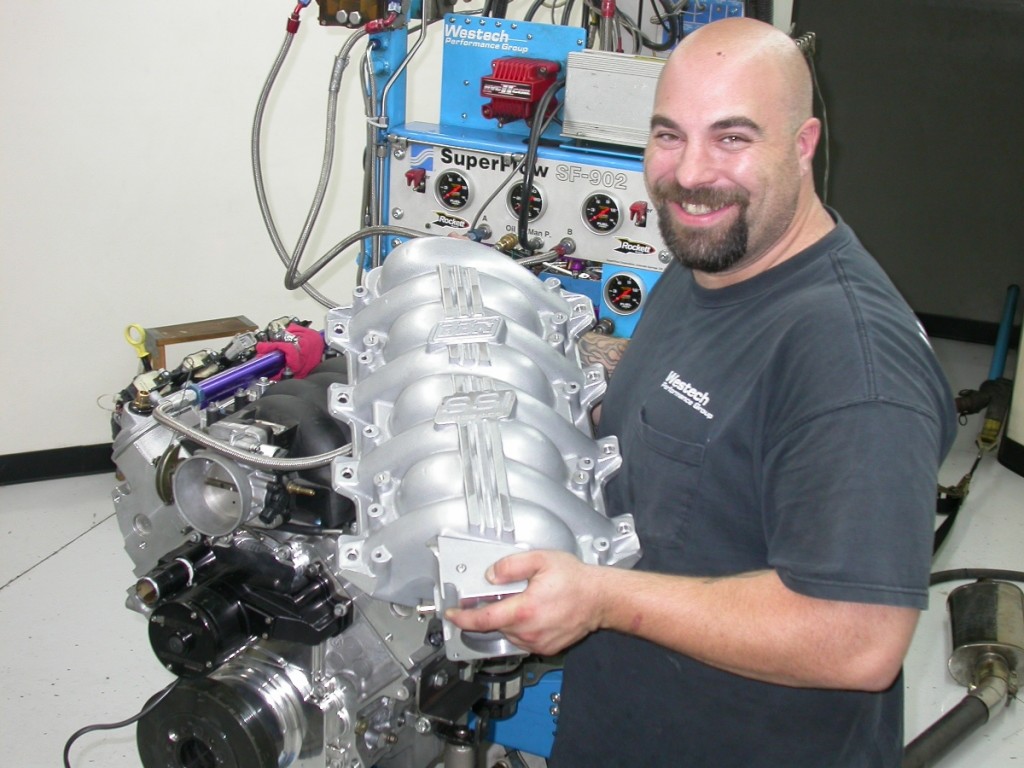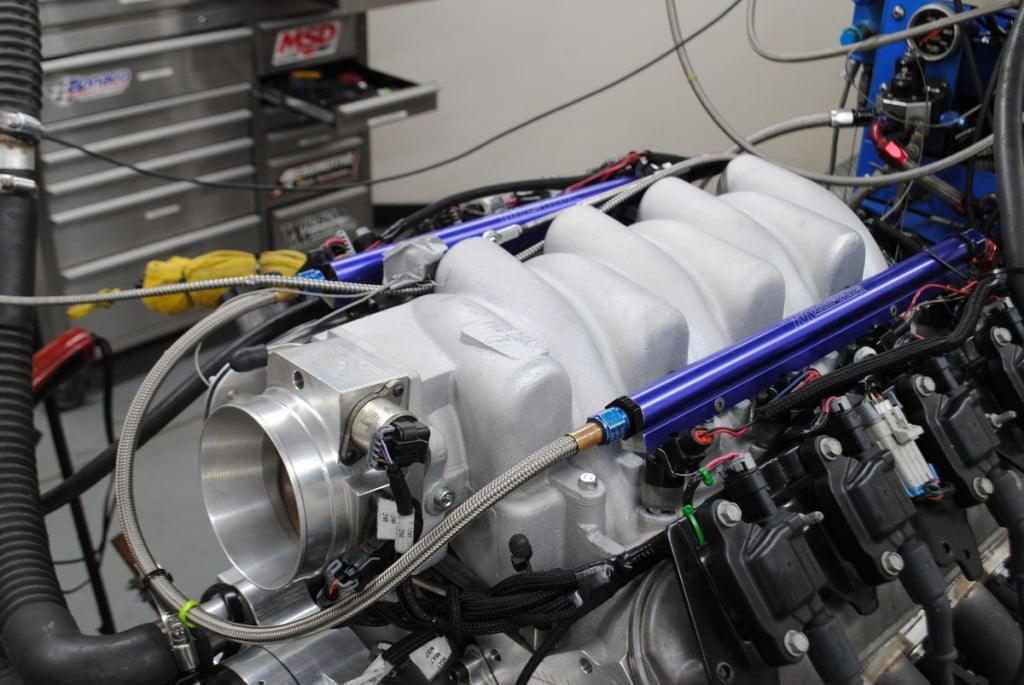
The BBK SSI and Speedmaster Qualifier (inset) intake looked impressive, but how did it compare to the factory intake?
Words and Photos: Richard Holdener
Just how important is an intake manifold to a performance combination? While no single component can transform a bad combination, the wrong intake can certainly hurt the right one. The factory LS induction system has a lot to offer. Hopefully this doesn’t come as a big surprise, as the intake manifold was designed not as an individual component, but rather as part of a system. The engineers designed the induction system to meet specific needs that naturally included, but were not exclusive to, power output. Were this the case, their expertise would make short work of extra power production.
Factory goals were much more numerous and often conflicting, consisting of things like cost analysis, noise considerations and even ease of initial installation (on the assembly line). Add to that list component weight, strength, and longevity, as well as fuel economy and emissions, and you start to understand their design dilemma. Meeting these design goals made for an impressive factory component (or components), but as luck would have it, it also opened the door for potential power improvements by the aftermarket.
To illustrate the gains offered by two aftermarket intake manifolds, from BBK and Speedmaster, we put them to the test on a modified 6.0L test motor. Before getting to the results, it is important to understand why intake manifolds are much more than simple airflow devices. If we remember our physics, the LS engine is a glorified air pump, where the more air it can process, the more power it will produce. The problem with this rather general description is that overall airflow improvements don’t always come from individual components that happen to flow more air. The long-runner, LS intake is a perfect example. If big airflow numbers were the limiting factor, it would be a simple matter of shortening (or increasing the size of) the runners to improve flow. The flow bench tells us that larger, shorter intake ports flow better than longer, narrow ones, but why does this not equate to extra power?
Taking a close look at the factory (and our two aftermarket intakes), we see that none of the trio offer short, over-sized runners. Instead, they all feature long(er) runners with reasonable cross sections. One reason for the factory design is obviously for fitment (the tight confines of the engine bay under the hood of a late-model Vette), but the other is something we refer to as charge filling. Both the length and diameter (or cross-section) of the intake runner determine the effective operating range. As such, the intake manifold runner length must be tuned to work in conjunction with the cam profile, head flow, and even exhaust primary tubing diameter (assuming a long-tube header) to optimize power production in a given rpm range. Failure to tune the intake runner length will result in less power rather than more, almost regardless of the airflow numbers of the port itself. Thus, a runner that flows less air can make more power in the desired operating range than one that flows more. In this case, less really is more!
Obviously, the guys at both BBK and Speedmaster understood what goes into the design of an intake manifold, as not only did the two intake designs offer substantial power gains over the factory piece, there were no trade offs in power down low associated with the peak-to-peak gains. Given the rpm-dependant nature of an intake manifold, it is a simple enough task to improve the power output at one end of the rev range by shortening (or lengthening) the runner configuration. Unfortunately, this often has a negative effect at the opposite end. Given the amount of time and energy that went into the factory manifold, it is often difficult to improve the power output throughout the rev range, but that is exactly what these two intake upgrades managed to do. As much as we like to see peak power gains, we like it even more when those gains come with no trade-off in power elsewhere in the curve.
To properly test the two intakes, we assembled a 6.0L test motor. Starting with an iron 6.0L block, we upgraded the LQ4 with forged internals from CP/Carrillo. The stock crank was more than sufficient for our needs, but the stock rods and pistons were replaced by a set of Bullet-series Carrillo rods (6.125-inch) and CP forged, flat-top pistons. The forged flat-top pistons offered valve reliefs to allow us to run an aggressive cam profile without fear of piston-to-valve interference. The reliefs dropped the static compression slightly (compared to stock), but the missing compression was made up for with smaller chambers in the AFR LSX 230 V2 cylinder heads. To go with our AFR-headed 6.0L, we installed a COMP 469 cam that offered a .617/.624 lift split, a 231/247-degree duration split, and 113-degree lsa. Finishing up the 6.0L combination was a set of Kooks step headers (1 ¾ to 1 7/8-inch) feeding Magnaflow mufflers, a FAST XFI management system and Holley 50-pound injectors.
The first order of business was to establish our baseline power with the factory LS1 intake. Run in anger with the stock intake, the modified 6.0L produced 535 hp at 6,900 rpm and 468 lb-ft at 5,100 rpm. Obviously, the healthy cam and AFR heads allowed the motor to rev cleanly up to 7,000 rpm, even with the stock intake. After running the stock intake, we installed the Speedmaster Qualifier intake and FAST Big Mouth throttle body. After minor tuning to optimize the air/fuel ratio, the 6.0L produced peak numbers of 561 hp at 6,900 rpm and 478 hp at 5,000 rpm. The power was up substantially at the peak, but we liked the fact the Speedmaster Qualifier traded no power down low.
The final test with the BBK SSI intake produced peak numbers of 568 hp at 6,900 rpm and 489 lb-ft of torque at 5,400 rpm. Like the Speedmaster unit, the aluminum BBK SSI intake offered substantial gains with no penalty elsewhere in the curve-precious metal indeed!

Our aftermarket fuel rails and Holley injectors bolted right to the Speedmaster intake. After tuning, the new intake increased the power output of the 6.0L from 535 hp and 468 lb-ft of torque to 561 hp and 478 lb-ft of torque.
Sources: AFR, Airflowresearch.com; ATI, Atiracing.com; ARP, Arp-bolts.com; BBK, bbkperformance.com; COMP Cams, compcams.com; CP Pistons/Carillo Rods, Cp-carillo.com; FAST, fuelairspark.com; Holley/Hooker/Weiand, holley.com; Lucas Oil, Lucasoil.com; Speedmaster, Speedmaster79.com.

















